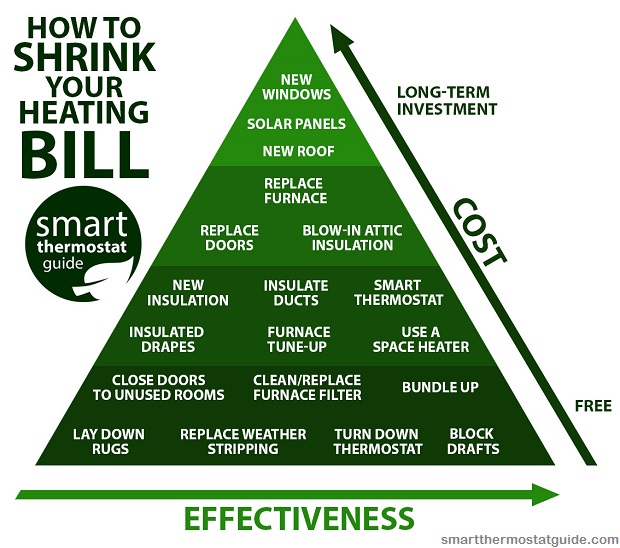The future is not what it used to be. In case you didn’t know, the summer of 2014 was one of the coolest on record, with temperatures under the 90 degree mark being the norm.
Or, to put it bluntly, the global warming proved to be actually a “marketing” myth. The reality is that we’re actually being confronted with a global cooling and after one of the coldest summers in recent years, we should prepare ourselves for a tough winter ahead.
{adinserter usdeception}Yes, dark, cold and miserable days are coming folks. Along with the cold winter months, you’ll suffer from the winter blues too, courtesy of your energy bill (at least partially).
Unfortunately the price of energy/heating fuels is on the rise while the wages are stagnating and economic recovery sometimes feels like it’s just another myth. But yet, there’s no inflation, right?
So, what can be done in order to lower your heating bill this winter? Stick with me and I will show you four simple energy saving ways that will help get through the cold season.
Step 1: Home Insulation
This should be an obvious answer for everyone and yet it’s often disregarded (maybe because it requires some investments initially, but they’re worth it in the long run).
Having an efficient home insulation system is similar to wearing the proper clothing on a cold winter day. The principle is the same, conserving energy and preventing the loss of (body) heat.
So, the general idea is to make your home as snug as physically possible, meaning that both the walls and the attic should be properly insulated. Well-insulated walls, ceilings and attics will make a world of difference in cutting your energy bill.
Insulating walls is not the easiest job in the world, nor the cheapest, but it’s very effective long-term. The same principle applies to attic/ceiling/floor insulation. Just to get an idea, a well-insulated home will reduce heating costs by up to 50-60 percent and that’s a lot in our book.
Along with wall and ceiling insulation, you should consider using high-efficiency windows (you should go for ENERGY STAR windows) and also properly seal leaky duct work and doors.
You should seal all drafts in window frames using foam sealant or silicone caulking and when it comes to switches and electrical outlets, you can use draft gaskets. On doors and windows, you should use weather stripping. Don’t forget to take care of pet doors too, if any.
All these things combined will help lower your energy bill during both wintertime and in the summer, because those AC systems use power too and if the heat can get out, the same goes for the cool air when it’s 100 degrees outside.
Step 2: Heat Conservation
Even in the winter, you should take advantage of the sun for heating your home since it’s absolutely free of charge. This trick is called passive solar heating and it works like this: just open your drapes when the sun is shining during the day (the south/west facing windows) and after sunset, close them again (this helps with heat insulation during nighttime).
If you have a fireplace, keep the damper shut when it’s not in use, thus preventing the heat from escaping through the chimney. If you’re not using the fireplace at all, you should permanently block the chimney using special rigid insulation.
You can re-arrange your furniture during winter so you’ll not be sitting near external walls, too. They tend to be colder than other spots in the room.
The same principle applies with drafty spots. You should avoid them like the plague and if it’s at all possible, fix the draft ASAP because if cold air’s getting it, warm air’s getting out and wasting your energy.
Take care of your heating system. Maintain it regularly and keep it working with maximum efficiency. Keep in mind that a wood burning stove or a wood fireplace is way more efficient in terms of heat conservation than a gas fireplace/oven.
Also, you can use scrap wood, pellets and what not (cheap stuff) in a wood operated heating system, meaning that you’re energy-independent. That certainly counts for something.
Heat tends to go up, hence reversing your ceiling fans, if any, is a nice trick that prevents dissipating the heat through the roof in the winter.
If you’re using an old thermostat, you should consider upgrading it with a programmable unit that permits you to lower the temps while you’re at work or sleeping. Also, keep the thermostat as low as possible (without causing discomfort) and the temperature in a nice steady range. If your living space is not vast, you should consider a space heater instead of using a central home heating unit.
Another nice trick for conserving energy during winter is to use heavy curtains or blankets over windows (except for when using the sun’s heat obviously) and around the bed, thus conserving trapped body heat during the night.
Dress properly for the cold season. If you’re dressed in shorts and a tee shirt in January, your thermostat is way too high. Stay warm at night using comforters and blankets; don’t be afraid to use an extra pair of socks or a blanket instead of turning up the heat.

Step 3: Consumption Control
Using less energy means leaving more money in your pocket at the end of the month. Consumption control is the next logical step in our quest for lowering the heating bill during the winter.
Consumption control translates into eliminating wasted energy. That means turning off lights when they’re not necessary (unoccupied rooms for example), taking shorter showers during the winter (thus saving tens of gallons of unnecessary hot water), unplugging unused electrical equipment (fans, refrigerators), using cold water for washing dishes and clothes (if possible), always doing full loads of everything, and using the sleep function on your TV/computer/monitor.
The easiest way to minimize electricity loss is to use Energy Star compatible electronics and appliances. Keep in mind that low flow faucets and showerheads will dramatically cut your hot water expenses.
Step 4: Smart Fuels
Last but not least, choosing smart fuels can help with lowering your heating bill dramatically during harsh winters. What are smart fuels, you may ask?
Approximately half of all American homes are using gas for heating and cooking during wintertime. Gas became hugely popular due to the breakthrough in the fracking technology in recent years, which made the prices drop.
There are alternatives to that. We won’t get into solar panels or anything the like, but the good old fashioned (and renewable) wood is still a viable option that’s regaining popularity.
As we already discussed, a home heating system using wood is sometimes the best choice (and also very efficient) when it comes to achieving energy independence. It’s way easier to gather wood and other combustible goods for heating than to be reliant upon electricity or gas from your utility company.
You can use a wood stove for heating/cooling and also use wood pellets, wood chips, coal, or whatever is available to you vs natural gas or electricity that you have to have piped in. Even if natural gas is generally thought of as being the most economical way for heating your residence, wood is very competitive also, even more affordable in certain places or situations.
The most important thing about using wood for heating your home is that it takes you off the grid completely. Also, it’s cost-competitive, you’ll have more price certainty (natural gas prices are fluctuating) and you can always stockpile wood when the price is “right” (yes, wood prices are fluctuating too, but they are generally way more stable).
You can use wood or wood pellets or any other inflammable material in ANY location, as opposed to natural gas, which is not available everywhere. There are many ways to heat your home using wood, ranging from the traditional wood stove to the latest high tech ultra-efficient furnaces that are using pellets (made of wood, wheat, corn, cardboard or whatever).
If you have other thoughts or ideas, don’t hesitate to share them in the comment section below.
by Chris Black





